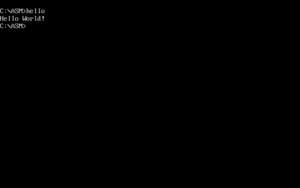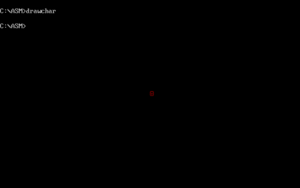Output
Contents
[hide]Outputting to the screen
First, be aware of the MSDOS memory layout
Outputting in Textmode (80x25)
Hello World / High Level function
Here's an obligatory "Hello World" program in text mode, using a "high level" MS-DOS function. With a small optimization already included (using XCHG BP,AX instead of MOV AH,09h), this snippet is 20 bytes in size.
org 100h ; we start at CS:100h
xchg bp,ax ; already a trick, puts 09h into AH
mov dx,text ; DX expects the adress of a $ terminated string
int 21h ; call the DOS function (AH = 09h)
ret ; quit
text:
db 'Hello World!$'
Low level access
The following three snippets showcase how to draw a red smiley in three different ways. All example snippets are meant to be standalone programs, starting with the first instruction and nothing before it. The target coordinate (40,12) is about the middle of the screen. We need a multiplier 2 since one char needs two bytes in memory (char and color is a byte each). The high byte 0x04 means red (4) on black (0) while the 0x01 is the first ASCII char - a smiley.
push 0xb800
pop ds
mov bx,(80*12+40)*2
mov ax, 0x0401
mov [bx],ax
ret
push 0xb800
pop es
mov di,(80*12+40)*2
mov ax, 0x0401
stosw
ret
push ss
push 0xb800
pop ss
mov sp,(80*12+40)*2
mov ax, 0x0401
push ax
pop ss
int 0x20
You might notice that the push <word> + pop seg_reg combination is always the same and occupies four bytes alltogether. If correct alignment is not important to you and you really just want any pointer to the screen, there is another way to get a valid one:
les bx,[si]
nop
stosb
That's also four bytes, but it already has the stosb opcode (for putting something onto the screen) integrated and even one slot free for another one-byte-instruction. It works because SI initially points to the start of our code, and stosb has the hexadecimal representation of 0AAh. After the first command, the segment register ES contains the value 0AA90h. If you repeatedly write something to the screen with stosb you will eventually reach the 0B800h segment and chars will appear on the screen. With a careful selection of the free one-byte-opcode you can also reintroduce some alignment. This works also with the stosw opcode 0ABh.
Alternative high level functions
Besides the direct way of accessing memory there are also other ways of bringing char to the screen (f.e)

